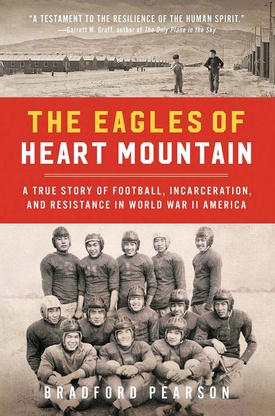For a number of years I have been working on a sports and society book treating the social and cultural transformation of Southern California in the early Cold War period through the lens of prep football as epitomized by a Dec. 14, 1956, California Interscholastic Federation championship game between Downey High School and Anaheim High School played before a record crowd of between 40 and 60,000 fans at the Los Angeles Coliseum.
I sensed that I was stalled in completing it by a fatal flaw, but did not fully realize what precisely that flaw was until I ran across a March 5, 2021, Washington Post critical assessment by Samuel G. Freedman of Bradford Pearson’s stunning book here under review. The author of the 2013 book Breaking the Line: The Season in Black College Football That Transformed the Sport and Changed the Course of Civil Rights about the conjunction between Black college football and the Civil Rights Movement, Freedman believes The Eagles of Heart Mountain to be a brilliant and beautifully written book, one that shrewdly treats the gridiron exploits of the Heart Mountain High School football team within the context of anti-Japanese racism before and during World War II. But he feels that the book suffers from one major liability: “the context crowds out the primary story line.” I agree wholeheartedly with Freedman’s double-edged assessment.
Pearson’s book is organized within three parts. In the first and second chapters of Part I, the author strikingly introduces readers to the two seasoned Nisei footballers — star quarterback Tamotsu “Babe” Nomura and stalwart tackle George “Horse” Yoshinaga. As best friends they serve as the protagonists within the book’s dramatic account of how a ragtag football squad of largely unproven teenage inmates at the Heart Mountain concentration camp in Wyoming became arguably that state’s very best high school team in the 1943-1944 seasons by winning all of its games but one, and aside from that narrow loss, shutting out its other opponents.
Pearson then shifts gears in the remaining three chapters of Part I and all seven chapters of Part II, wherein he exquisitely narrates a richly detailed, well-documented, and exceedingly insightful overview of the harshly discriminatory Japanese American historical experience leading up to Japan’s Dec. 7, 1941, attack on Pearl Harbor and the subsequent chain of events responsible for the U.S. government’s unjust mass eviction of some 120,000 Americans of Japanese ancestry in 10 euphemistically named “relocation centers.”
Although Pearson artfully threads the Nomura-Yoshinaga spearheaded Heart Mountain football saga foregrounded in the book’s title through some of these chapters, it only takes center-stage within five brief action-packed chapters of Part III.
The disproportionate structure of Pearson’s book is bound to disappoint those readers who understandably will expect that the social and cultural portion of the book should take a back seat to the sports portion. Nonetheless, such readers should be mindful that while the latter section of “The Eagles of Heart Mountain” is far more exhilarating, the former section is far more significant and, accordingly, should not be glossed over or, worse still, skipped entirely.
Personally, my favorite part of the book consists of those superb chapters in Part III wherein Pearson intertwines his football story in conjunction with that of the Heart Mountain draft resistance movement involving 85 youthful Nisei (including footballer Tayzo Matsumoto) who supported the position of the inmate Heart Mountain Fair Play Committee and refused induction into the military until their U.S. citizenship rights were restored. Thanks in part to the ardent “patriotic” advocacy of Heart Mountain’s Caucasian administrators as well as the collaborative staff of the Heart Mountain Sentinel newspaper, including sports writer Yoshinaga, both the draft resisters and the FPC leadership were successively tried in the same Cheyenne federal court and meted out multi-year prison sentences.
Ironically, in the early 1990s, at a time when Yoshinaga was a quarrelsome columnist for the Los Angeles-based Rafu Shimpo newspaper, he engaged in an extended vitriolic press debate with former FPC leader Frank Emi, a black belt judoist, which spilled over into a front-page piece in the Los Angeles Times. Whereas Emi characterized the draft resisters as courageous civil rights heroes, Yoshinaga outrightly dismissed them as “draft dodgers” and “chickens.” Privately, along with numerous other onetime draft resisters from Heart Mountain and other camps, Emi referred to Yoshinaga as a “Horse’s Ass,” but he also conceded that “Horse,” however inadvertently, had given the resisters the public attention and attendant respect and admiration that they heretofore had lacked.
In spite of The Eagles of Heart Mountain being Pearson’s first book, it is undeniably a seminal one.
THE EAGLES OF HEART MOUNTAIN: A TRUE STORY OF FOOTBALL, INCARCERATION, AND
RESISTANCE IN WORLD WAR II AMERICA
By Bradford Pearson
(New York: Simon & Schuster, 2021, 400 pp., $28, hard cover)
*This article was originally published in the Nichi Bei Weekly on July 22, 2021.
© 2011 Arthur A. Hansen / Nichi Bei Weekly








